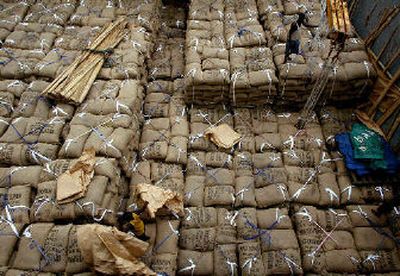War fueled by chocolate

ABIDJAN, Ivory Coast — On the streets of this skyscraper-lined West African metropolis, tension and rumors of an imminent return to war are always thick in the air — and so too, is the sweet smell of chocolate.
Despite more than half a decade of coups, fighting and failed peace deals, a $2 billion a year cocoa industry is a booming in Ivory Coast, producing more of the raw material for chocolate than any other country on the planet.
Production has ranged between 1.2 million and 1.4 million tons annually in the last half decade, or about 40 percent of world supply. The United States is the biggest importer, buying about 70 percent of the crop.
“Cocoa is Cote d’Ivoire,” said Daniel Abo, a lawmaker and vice president of the national Cocoa and Coffee Board. “It has built this country.”
And, some might argue, it’s also helped ruin it.
At a time when most international aid has been suspended because of the conflict, profits from the industry are helping support the loyalist south and its army, as well as cocoa-smuggling rebels who control the northern half of the country. Cocoa contributes 43 percent of the gross national product.
Abo denied the crop was fueling the country’s three-year conflict.
“Cocoa is not produced to fund war,” he said. “We use this money to pay civil servants, build schools, develop the country.”
In Abidjan’s swank Zone 4 district, smoke pipes out from cocoa factories processing the beans. The heavy, thick aroma of chocolate hangs in the air.
Near one of the factories stands Adama Tarnagda, an immigrant from Burkina Faso who fled the cocoa farm he worked on in southeastern Ivory Coast three years ago, after fighting broke out there. Now he works in Abidjan, lowering and raising the barrier at train crossings.
“Today when I smell the scent of cocoa, I think of my field and it eats away at my heart,” Tarnagda said. “Cocoa has brought us life. The day the war ends, I’ll go back.”
Ivory Coast’s fertile farms attracted millions of immigrant laborers from across West Africa for decades — so many, in fact, that they and their descendants are believed to account for up to 40 percent of the nation’s 17 million people today.
The immigrants helped develop the nation, but also sparked xenophobic resentment that was exacerbated when world cocoa prices fell in the 1980s.
Former President Henri Konan Bedie, overthrown in the country’s first coup in 1999, seized on the issue for political gain, introducing the fiercely nationalistic concept of “Ivorianess.”
Today, “Ivorianess” is at the heart of a split between the loyalist-held south and the north, held by rebels since a failed 2002 coup bid.
Northerners complain they are treated as foreigners in their own country by southerners — marginalized and discriminated against, denied passports and even national identity papers, despite being born here.
Though the country has been mostly been calm since a 2003 peace deal, violence still erupts in places like the cocoa-rich western town of Duekoue, where immigrant farmers known as Dioulas clashed with local ethnic Guere communities in June, leaving up to 100 people dead.
Abo estimated that about 10 to 15 percent of the country’s 600,000 farm laborers have fled over the last few years, but he said the effect on output was minimal.
Gassou Toure, director of raw materials department at the Agriculture Ministry, said production would have increased because new farms have boosted production slightly in the last few years, but since farmers have fled, production levels have stayed about the same.
According to a November U.N. report, Ivory Coast produced 1.23 million tons of cocoa in the 2004-2005 season. The 10 percent decrease from the previous year has been blamed mostly on poor weather, not the conflict, though the report did cite “the departure from the cocoa areas of large numbers of migrant workers in fear of ethnic persecution.”
Susan Smith, spokeswoman for the U.S.-based Chocolate Manufacturers Association, said the decline in Ivorian production has had a negligible effect on chocolate prices so far. Cocoa market prices have not varied much the last couple of months, although they have gone up slightly the last two weeks, Smith said in an e-mail to the Associated Press.
The cocoa industry is a sensitive subject here. Secrecy is such a priority that the government doesn’t publish official production figures. French-Canadian journalist Guy-Andre Kieffer, who wrote articles about corruption in Ivory Coast — including its cocoa industry — disappeared in the country in 2004 and was believed murdered.
Production estimates cited in the U.N. report do not include cocoa smuggled illegally to neighboring countries to escape high Ivorian taxes and take advantage of better prices in places like Ghana, to where the U.N. said 150,000 tons of Ivorian cocoa was smuggled last year.
The vast majority of the crop is grown in government-held territory, but the U.N. report said rebels use cocoa, along with gold, diamonds and timber, to fund “their military activities, as well as for personal profit.”
On the other side, the U.N. said, the government “is dependent on the cocoa crop to maintain solvency and succeed in paying its civil servants, including the military.”